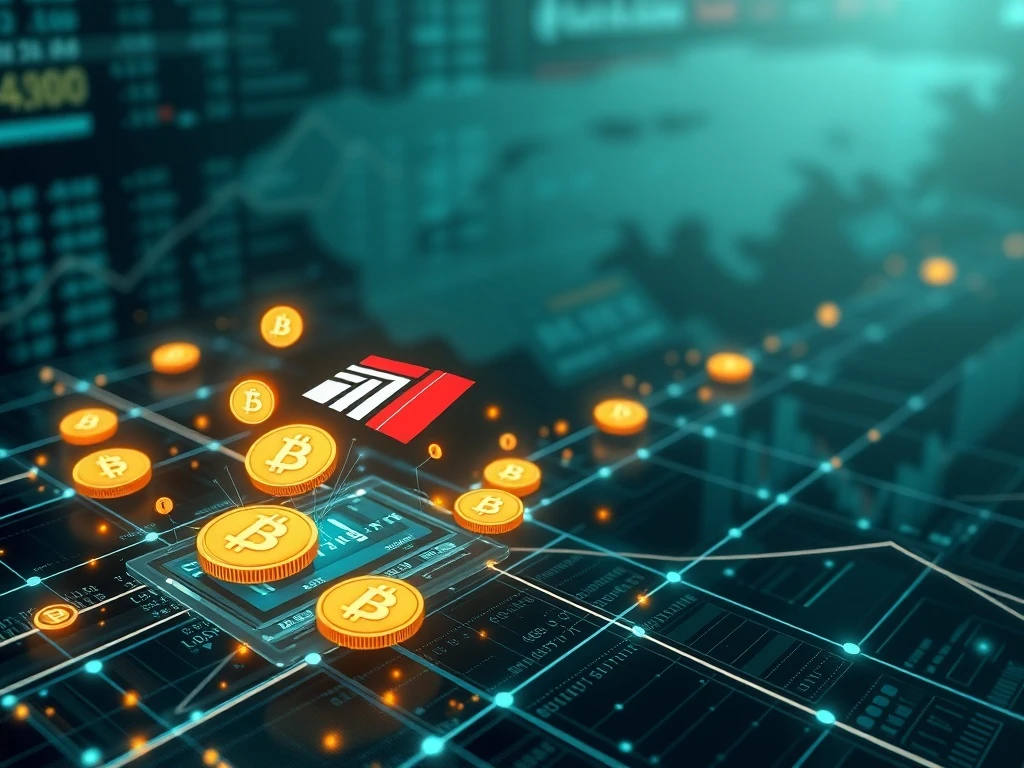Bank of America Stablecoins: Unlocking Trillions in Transactions

The financial world is witnessing a seismic shift, and at its forefront is Bank of America (BoA). Imagine a world where trillions of dollars in client transactions move with unprecedented speed and efficiency. This isn’t a distant dream; it’s the potential reality BoA is actively exploring through the adoption of Bank of America stablecoins. This strategic move signals a growing acceptance of digital assets within traditional finance, promising to revolutionize how large institutions handle their daily financial flows.
Why are Bank of America Stablecoins a Game Changer?
Bank of America, a titan in the global financial landscape, is venturing into the realm of stablecoins, aiming to transform its payment infrastructure. CEO Brian Moynihan confirmed the bank’s early-stage exploration during a recent earnings call, emphasizing stablecoins as a “transactional device.” This means leveraging digital currencies pegged to fiat assets like the US dollar or euro to facilitate massive client transactions. With trillions of dollars flowing through BoA’s systems daily, stablecoin-based payment rails could offer significant advantages. Moynihan articulated this vision clearly: “We believe that if they want to use stablecoins to move part of that money, they’ll move.”
The bank’s interest in stablecoins isn’t new; it has been actively researching their potential for some time. Discussions have even included the possibility of issuing a stablecoin jointly with other banking giants, such as JPMorgan and Citigroup. This collaborative approach underscores the industry’s recognition of stablecoins’ potential to streamline cross-border payments, reduce settlement times, and lower transaction costs.
The Accelerating Stablecoin Market
The momentum behind the stablecoin market is undeniable. Industry experts increasingly view these fiat-pegged assets as the emerging “default settlement layer” for the internet. Recent data highlights this growth: stablecoin transaction volumes surpassed those of Visa and Mastercard combined in 2024. This remarkable milestone demonstrates their growing utility and adoption. Since the beginning of 2023, the total value of stablecoins in circulation has nearly doubled, soaring to an impressive $257 billion.
The market is largely dominated by two key players:
- Tether’s USDt (USDT): The largest stablecoin by market capitalization, widely used for trading and remittances.
- Circle’s USDC (USDC): A close second, known for its strong regulatory compliance and transparency.
Together, USDt and USDC account for over 85% of the entire stablecoin market, indicating their pivotal role in this evolving digital financial ecosystem.
Unlocking Efficiency with Blockchain Payments
At the core of BoA’s stablecoin strategy lies the power of blockchain payments. Unlike traditional banking systems that rely on complex interbank networks and often slow settlement processes, blockchain offers a decentralized, transparent, and near-instantaneous method for transferring value. For a bank handling trillions in daily transactions, the benefits are profound:
- Faster Settlements: Transactions can settle in minutes, not days, significantly improving liquidity and operational efficiency.
- Reduced Costs: Eliminating intermediaries and manual reconciliation processes can lead to substantial cost savings.
- Enhanced Transparency: Blockchain’s immutable ledger provides a clear audit trail for every transaction.
- Global Reach: Stablecoins can facilitate seamless cross-border payments, overcoming traditional banking hurdles like varying operating hours and correspondent bank networks.
While the initial focus for BoA is on stablecoins as a transactional device, the underlying blockchain technology opens doors for broader applications within their vast financial infrastructure.
Navigating the Regulatory Landscape: The GENIUS Act
The rapid growth of the stablecoin market has caught the attention of policymakers, making stablecoin legislation a priority. The proposed GENIUS Act is a prime example of these efforts. This bill aims to provide a clear regulatory framework for stablecoins in the United States, addressing concerns around consumer protection, financial stability, and anti-money laundering (AML) measures.
The journey of the GENIUS Act through Congress has been illustrative of the complexities involved in crypto regulation:
- It gained bipartisan support within the Senate Banking Committee.
- It successfully passed the Senate in June.
- However, it faced a snag in the House of Representatives, stalling after a group of lawmakers blocked a key procedural vote.
Despite this temporary setback, the bill is expected to proceed to a floor vote in the House, indicating a strong political will to establish clear rules for digital assets. Regulatory clarity is crucial for large institutions like Bank of America to fully commit to stablecoin adoption, as it mitigates legal and compliance risks.
The Broader Trend: Financial Institutions and Crypto
Bank of America’s exploration is part of a larger, undeniable trend: the increasing engagement of financial institutions crypto. Once wary, legacy financial players are now actively exploring and integrating digital assets into their strategies. JPMorgan, with its JPM Coin, and Citigroup, with its similar considerations, are notable examples. This shift is driven by several factors:
- Client Demand: A growing number of institutional clients are seeking exposure to digital assets or more efficient payment solutions.
- Technological Innovation: Blockchain offers inherent efficiencies that traditional systems struggle to match.
- Competitive Pressure: Fintech companies and crypto-native firms are pushing the boundaries, compelling traditional banks to innovate.
While challenges remain, particularly around regulatory uncertainty and operational integration, the move by major banks signals a long-term commitment to a future where digital assets play a significant role in global finance. BoA’s measured yet deliberate approach reflects the careful consideration required for such a large-scale transition.
Conclusion: A New Era of Financial Transactions
Bank of America’s deep dive into stablecoins represents a monumental step towards integrating digital assets into mainstream finance. By exploring how stablecoins can move trillions in client transactions, BoA is not just adapting to a new technological landscape; it is actively shaping it. The growth of the stablecoin market, the promise of efficient blockchain payments, and the ongoing push for regulatory clarity through initiatives like the GENIUS Act all point to a future where digital currencies are an integral part of our global financial infrastructure. As more financial institutions embrace crypto, we are truly entering an exciting new era of speed, efficiency, and innovation in financial transactions.







